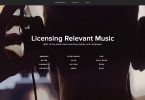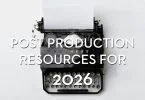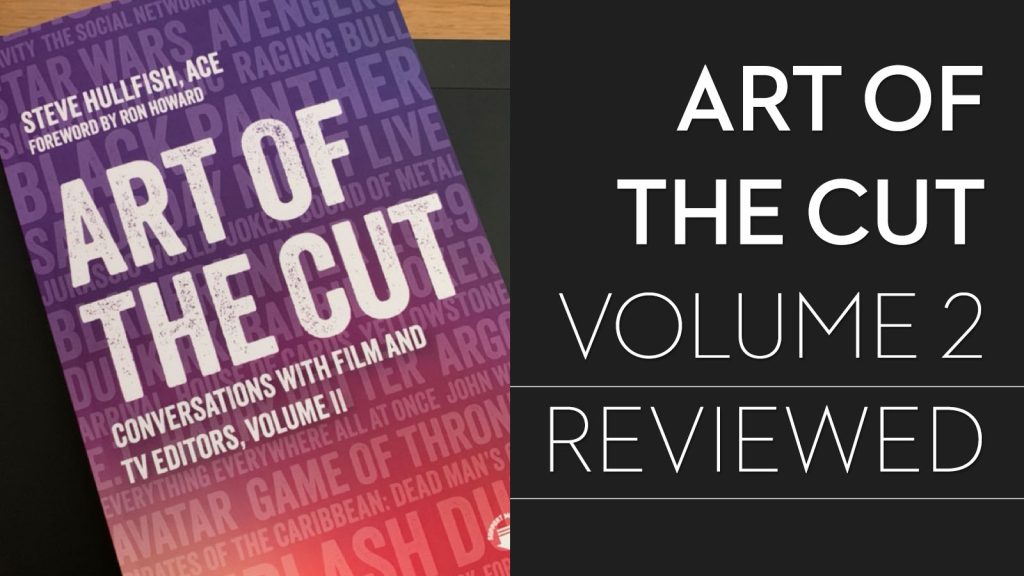
- Art of the Cut Vol 2. Reviewed
- Download 10 Free Bonus Chapters
- Interview with author Steve Hullfish, ACE
A small selection of books on the art and craft of film editing should adorn the shelves of every edit suite.
Art of The Cut Vol.1 and Vol.2 should be on that shelf.
In terms of ‘value per page,’ they must be up there with the very best.
Art of The Cut – Conversations with Film and TV Editors, Vol.2 is now available in all good bookshops and features the collective wisdom of over 300 editors!
If you’ve not heard of the Art of the Cut before, then you’re missing out on one of the longest on-going interview series with some of the best editors working today. Each one of those interviews is it’s own long-form conversation around the editing of a particular film.
The books have compiled the best of those conversations into topic-specific conversations that flow from one editor to another.
To give you a sense of what this volume covers, here are the four main sections of the book with example chapter titles of just some of the topics in each:
- #1 – Preparation
- Organisation
- Watching Dailies
- #2 – Creative – Micro-level editing decisions
- Performance
- Subtext
- Pace and Rhythm
- Music
- #3 – Creative – Macro-level editing decisions
- Storytelling
- Assembling Scenes into a Story
- Editor’s Cut
- Judging Editing
- #4 – Social
- Breaking in
- Collaborating with directors
- Assistant Editors
Each chapter bounces between the insights of too many talented industry-leading editors to list, yet flows in the natural conversation of peers.
For example, here is the opening to Chapter 17 – Editor’s Cut:
What to call that first edit?
Luis Carballar, Charm City Kings: In my opinion we shouldn’t call them editor’s cuts, because it’s not really your cut. You didn’t have time to do your cut and you’re not really cutting everything you would like to cut. I call it the assembly.
Michael Taylor, ACE, Nine Days: I generally don’t like to call it an “editor’s cut.” I like calling it an assembly because that way we can say it’s just “a version of the film.”
Chad Galster, ACE, Yellowstone: It’s common to call the first cut of a movie or a TV show the editor’s cut. I’ve never called it that. I call it a script cut.
Tom Eagles, ACE, Jojo Rabbit: I called it a “compile,” which was just all of the scenes in the movie.
Carol Littleton, ACE, My Dinner with Hervé: I hate to use the word assembly and think it should be named the editor’s first cut.
Harrison Atkins, Emily the Criminal: As the editor of the film, I don’t want to apply my own thing over the director’s idea for the film because often the result of that is a disunity, so I feel like philosophically, my approach to the process for deciding what’s right then becomes auditioning different possibilities for the director. I think of edits as auditions for the director.
Download 10 Free Bonus Chapters of AOTC Vol. 2
You can actually download the following bonus chapters of the book, directly from the Routledge website under the ‘Support Material’ section:
- Action and Stunts
- Ad Lib and Improvisation
- Choosing the Project
- Collaboration Amongst Editors
- Cutting Room Gear and Tech
- Film Grammar and Style
- Giving Script Advice and On-Set Advice
- NLEs and Scriptsynch
- Previs and Postvis
- VFX
- (Bonus) Research and Reading Source Material
While you can read these chapters by themselves it goes without saying that it’s well worth buying the physical book too!
If you’ve not already read Vol. 1 of The Art of The Cut, here’s my in-depth review and interview with Steve, plus links to the free bonus chapters from that book, too!
Art of The Cut Vol.2 – Editor’s Review
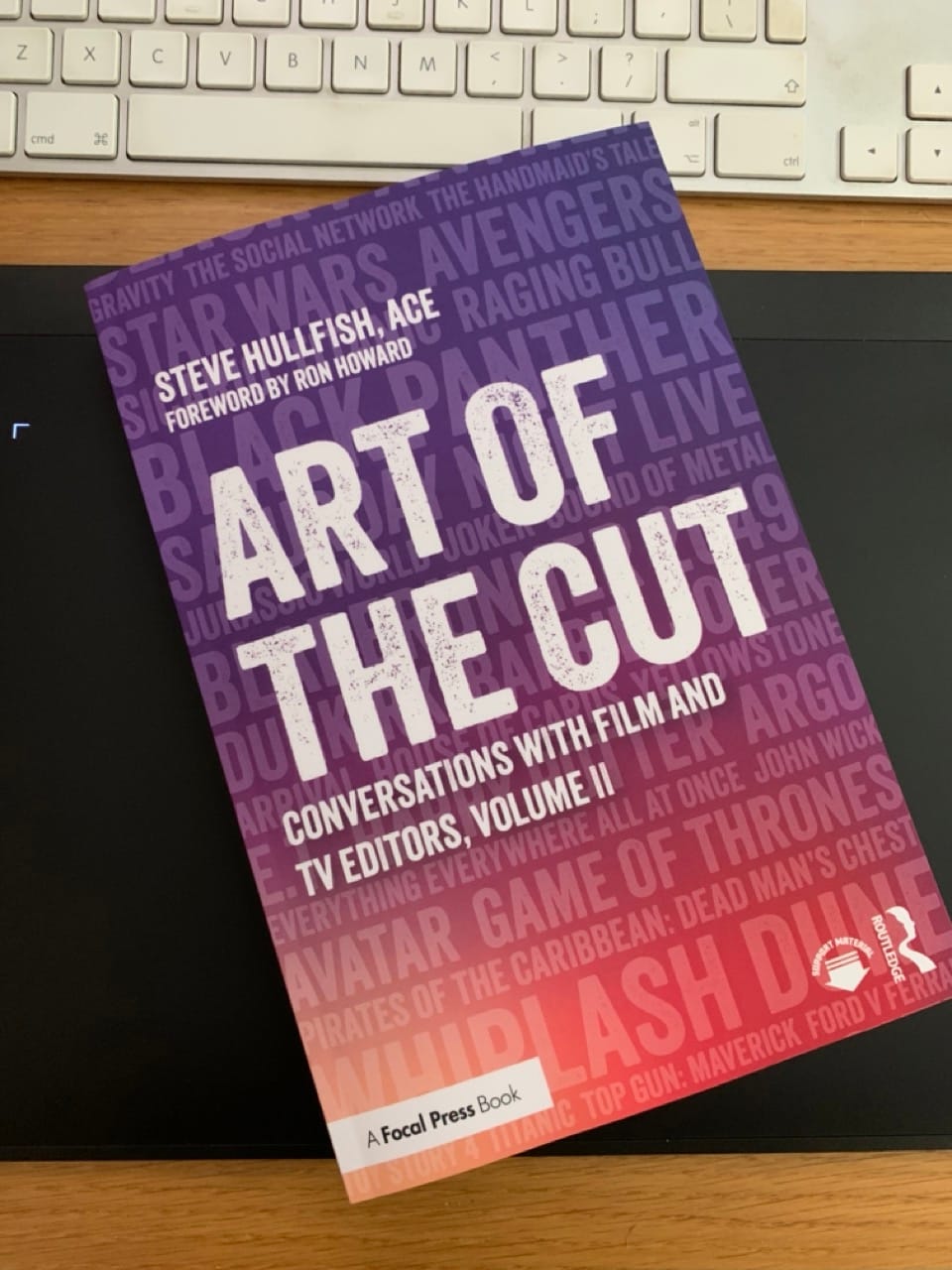
Personally, I loved this book because I’m a huge fan of the source interview series.
I love learning from other editors. I love learning more about the art, business, craft and technology of film editing. And I love stealing the best ideas from other creative people.
If you do too, then you’ll love this book. Because if you’re like me, I haven’t had the time to read every single ATOC interview or listen through every single podcast. So having a book like this on the shelf to leaf through
What I also love about the book is that where else will you get access to the collective wisdom of 300 working editors and benefit from their thousands of hours in the editing chair?
Nowhere!
So why wouldn’t you seize the chance to read a book like this from cover to cover and try to let your brain marinate in all of that insight?
This leads to two important points.
First, this isn’t the kind of book you’ll just want to sit and read cover to cover. It’s too densely packed with ideas and approaches to absorb it all in one hit.
Think of it as a reference guide to dip into for targeted wisdom or something to read a few pages of at a time while you’re waiting for a download or a render instead of doom-scrolling on your phone.
Second, is the price.
In the US, it’s close to $50 and in the UK £35. That’s pretty normal for an industry-specific limited-run ‘textbook’, but at first glance feels pretty steep compared to ‘a book’.
But it’s actually a steal.
Think of it as much cheaper than paying for 300 coffee dates to have conversations with your favourite editors.
Or put it on your Christmas wish list and be very good.
To finish this mini review, here’s one of my favourite sections on imposter syndrome in the edit suite:
Adam Gough, Roma: “I’ve always had a little bit of an imposter complex as well. I think it’s just because we care about what we do, and if we lose that, then we are probably going to lose the spark of what makes us good at what we do, so I will use that and pretend it’s a benefit.
William Goldenberg, ACE, Argo, Zero Dark Thirty: Fear definitely keeps me on my toes. I don’t think it’ll ever go away. I’ve been cutting on my own for 25 years and I still feel the same anxiety of wanting to get it right and going in every morning and not wanting to disappoint the director, of disappoint myself or disappoint the studio.
If it’s channeled correctly, that fear really keeps an edge. Almost every scene I cut – especially big sequences – especially when you’ve got seven hours of dailies for a four-minute dialogue scene and you think, “Oh my God! I have no idea how to cut this. None. I don’t know where I’m going to start.”
Steve Hullfish, ACE in Conversation
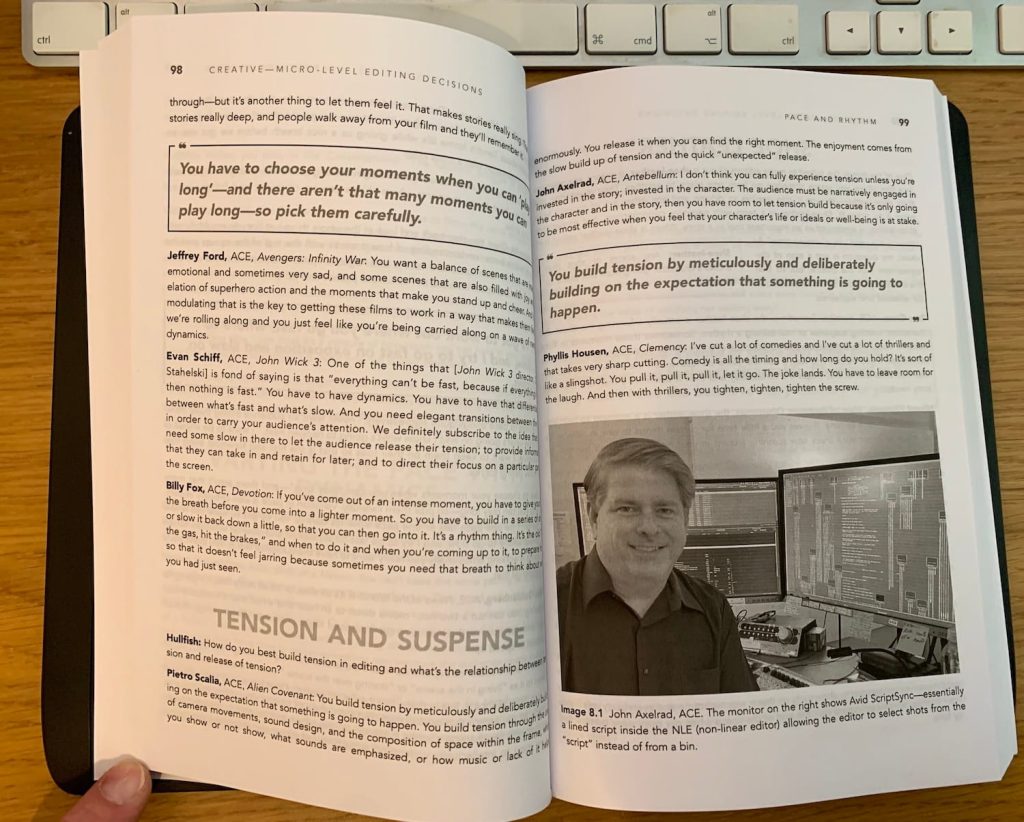
I wanted you all to hear from author and film editor Steve Hullfish, ACE on the huge effort that went into pulling this book together and what makes it such an essential read for every film editor.
Enjoy!
What’s happened since you published Volume 1?
Well, the biggest thing that happened since Volume 1 is that I talked to another 400 editors!
Volume 1 included only about 50. Volume 2 includes almost 300.
I set aside about 100 interviews with documentary film editors because that’s the basis of Volume 3 of Art of the Cut.
Also, the response has been pretty overwhelming.
There are some big Oscar-nominated editors out there who almost buy my book in bulk to give to their editing teams. I’ve had editors I respect and admire tell me that reading the first book launched them into their careers.
I was also proud to be included in the American Cinema Editors Society since the first book was published.
What’s new/different about Volume 2? Other than more of the same gold (good enough reason!) why should people read this one?
Volume 2 is indeed completely new content from Volume 1.
There is zero overlap in quotes and the approach and organization is different.
Obviously, some of the same themes or concepts are discussed, but from a completely new angle and perspective.
As far as gold is concerned, in Volume 2 the gold is even more refined.
Why?
Because both books are approximately the same length, about 130,000 words. But Volume 2 was distilled from nearly 3 million words of original transcripts, about six times more than Volume 1.
So in Volume 2, only the best of the best made it to the final pages.
If you look at it in movie editing terms, think of it like rushes, and an editor’s cut, and a final locked cut. For Volume 2, the rushes were 3 million words, which I cut down to an “editor’s cut” of 313,000 words and then compressed that down to the very best 130,000 words.
And actually, when you buy the book there are still 10 more chapters of really excellent content available online.
I had SO much more to say, and it just wouldn’t fit in the publishable size of the book. The online chapters are every bit as good as the ones in the printed version of the book.
So if you buy it, don’t forget to look at those chapters!
I’m also super proud of the Foreword that Ron Howard wrote.
It’s truly a love letter to editors and editing from a guy who really believes that editing is fundamental to the craft of cinema.
Actually, when I interviewed him, I said, “How do you think editing informs the art of cinema?”
And he said, “Well, some people would say that editing is the art of cinema!”
What were some of your biggest personal takeaways from compiling and editing this volume?
Just like with the first book, I conducted all of these interviews.
I prepared for them, I researched them, I asked the questions, and I even transcribed many of the interviews, but it wasn’t until I started putting the quotes next to each other in topics – into a virtual conversation – that I truly understood the power of some of the ideas.
Editing is such a personal and subjective art.
Everyone has their own process and approach. This book delivers on that.
A book with ONE editor’s ideas on how to edit is so limited.
I knew I wanted to show that there are SO many absolutely valid ways to approach the craft.
It has Oscar-winning editors disagreeing, young editors bringing new techniques, and wise, old editors delivering hard-won knowledge. It’s such a spectrum of advice.
I originally started doing these interviews because I didn’t come up through the assistant editor ranks.
I never really had a mentor.
I went straight into the editor’s chair, and I felt like I was missing something, so my curiosity led me to ask fellow editors about all the things I wanted to know about how to edit.
Interviewing these people and assembling this book, and the first volume, has really changed my perspective on editing and my approach to the craft.
Who was your most memorable interview?
That’s such a tough question.
My favorite interview subject is Joe Walker.
I’ve been interviewing him since the 1st or 2nd Art of the Cut interview more than a decade ago, and I’ve talked to him about every movie he’s cut since then.
He’s a fantastic editor and one of the few who are as good at talking about their craft as they are at doing it. Plus, he’s just somebody you want to sit around and drink a few pints with – or cups of tea, depending on the time of day.
Walter Murch is obviously a legend and a giant in our industry. He’s incredibly smart, well-read, and has a diverse outlook. I’ve done four interviews with him and met him twice. You really feel like you’re in the presence of greatness around him.
Other huge ‘gets’ for me were Thelma Schoonmaker and Anne V. Coates. Legends. Anne Coates – God rest her soul – was absolutely hilarious.
William Goldenberg, Tom Cross, Alan Heim, Paul Hirsch, and Eddie Hamilton are also fonts of knowledge and are so wonderful to talk to and generous with their time.
What is your favourite chapter in volume 2?
I like my intro to the Pace and Rhythm chapter.
The Miscellaneous Wisdom chapter has a CRAZY amount of killer stuff in it. That whole chapter is gold.
I like the Storytelling chapter.
The book really shouldn’t be read linearly. There’s no reason to read it in order.
The first chapter, Organization, is possibly the most boring (though incredibly useful) chapter. The online bonus chapters on editing Ad-lib and Improv are pretty great, too.
What’s next for AOTC?
More interviews for sure.
I’d love to have an app on Amazon Alexa Echo where you could have a stream of constant quotes on the screen all day from editors.
Or that you could put on the Art of the Cut Channel on your ROKU or Firestick or Apple TV and have visual quotes appear in a slide show on your TV.
Art of the Cut Volume 3 is already in the works.
It’s completely about documentary editing. I have almost 100 interviews with documentary editors now and by the time the book comes out, I hope to have it up to 100 interviews.
I’ve thought about doing an audiobook. I could definitely do audiobooks with me reading both books, but I’d love to have the actual voices of the editors, but it would be SO much work.
The original interview audio quality isn’t good enough for an audiobook, so I’d have to create a script for every editor in the book and ask them to read it and then edit it all together. It would be SO much work.
Any plans for an AOTC AI-chatbot?!
Coding AI chatbots isn’t really in my wheelhouse, but I know that Adobe has an Acrobat PDF service where you can essentially ask a PDF a question. But that’s only for documents that are about 100 pages long.
It would be cool if you could “query” the entire 3 million plus words of Art of the Cut interviews and have it kick back an answer, including dissenting points of view.
If somebody knows how to do it – and how to monetize it – let me know!
Thanks to Steve for taking the time to answer my questions!
What did you think of Art of The Cut Vol.2?
I’d love to know which chapters or quotes stood out to you from the Art of The Cut Volume 2 the most, so hit the comments and let me know!
Also what other books are in the pantheon of ‘the very best’ books on film editing for you?


